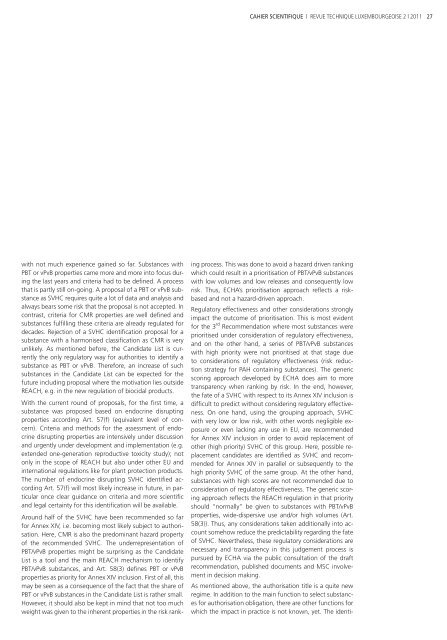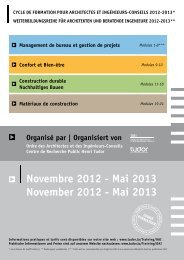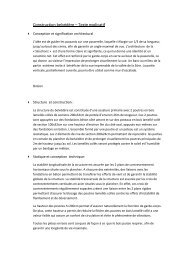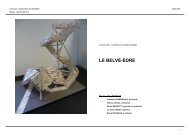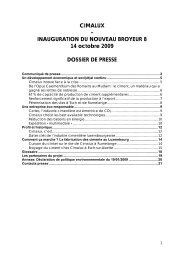Cahier Scientifique 02 | 2011 (PDF) - Revue Technique ...
Cahier Scientifique 02 | 2011 (PDF) - Revue Technique ...
Cahier Scientifique 02 | 2011 (PDF) - Revue Technique ...
Create successful ePaper yourself
Turn your PDF publications into a flip-book with our unique Google optimized e-Paper software.
CAHIER SCIENTIFIQUE | REVUE TECHNIQUE LUXEMBOURGEOISE 2 | <strong>2011</strong><br />
27<br />
with not much experience gained so far. Substances with<br />
PBT or vPvB properties came more and more into focus during<br />
the last years and criteria had to be defined. A process<br />
that is partly still on-going. A proposal of a PBT or vPvB substance<br />
as SVHC requires quite a lot of data and analysis and<br />
always bears some risk that the proposal is not accepted. In<br />
contrast, criteria for CMR properties are well defined and<br />
substances fulfilling these criteria are already regulated for<br />
decades. Rejection of a SVHC identification proposal for a<br />
substance with a harmonised classification as CMR is very<br />
unlikely. As mentioned before, the Candidate List is currently<br />
the only regulatory way for authorities to identify a<br />
substance as PBT or vPvB. Therefore, an increase of such<br />
substances in the Candidate List can be expected for the<br />
future including proposal where the motivation lies outside<br />
REACH, e.g. in the new regulation of biocidal products.<br />
With the current round of proposals, for the first time, a<br />
substance was proposed based on endocrine disrupting<br />
properties according Art. 57(f) (equivalent level of concern).<br />
Criteria and methods for the assessment of endocrine<br />
disrupting properties are intensively under discussion<br />
and urgently under development and implementation (e.g.<br />
extended one-generation reproductive toxicity study); not<br />
only in the scope of REACH but also under other EU and<br />
international regulations like for plant protection products.<br />
The number of endocrine disrupting SVHC identified according<br />
Art. 57(f) will most likely increase in future, in particular<br />
once clear guidance on criteria and more scientific<br />
and legal certainty for this identification will be available.<br />
Around half of the SVHC have been recommended so far<br />
for Annex XIV, i.e. becoming most likely subject to authorisation.<br />
Here, CMR is also the predominant hazard property<br />
of the recommended SVHC. The underrepresentation of<br />
PBT/vPvB properties might be surprising as the Candidate<br />
List is a tool and the main REACH mechanism to identify<br />
PBT/vPvB substances, and Art. 58(3) defines PBT or vPvB<br />
properties as priority for Annex XIV inclusion. First of all, this<br />
may be seen as a consequence of the fact that the share of<br />
PBT or vPvB substances in the Candidate List is rather small.<br />
However, it should also be kept in mind that not too much<br />
weight was given to the inherent properties in the risk ranking<br />
process. This was done to avoid a hazard driven ranking<br />
which could result in a prioritisation of PBT/vPvB substances<br />
with low volumes and low releases and consequently low<br />
risk. Thus, ECHA’s prioritisation approach reflects a riskbased<br />
and not a hazard-driven approach.<br />
Regulatory effectiveness and other considerations strongly<br />
impact the outcome of prioritisation. This is most evident<br />
for the 3 rd Recommendation where most substances were<br />
prioritised under consideration of regulatory effectiveness,<br />
and on the other hand, a series of PBT/vPvB substances<br />
with high priority were not prioritised at that stage due<br />
to considerations of regulatory effectiveness (risk reduction<br />
strategy for PAH containing substances). The generic<br />
scoring approach developed by ECHA does aim to more<br />
transparency when ranking by risk. In the end, however,<br />
the fate of a SVHC with respect to its Annex XIV inclusion is<br />
difficult to predict without considering regulatory effectiveness.<br />
On one hand, using the grouping approach, SVHC<br />
with very low or low risk, with other words negligible exposure<br />
or even lacking any use in EU, are recommended<br />
for Annex XIV inclusion in order to avoid replacement of<br />
other (high priority) SVHC of this group. Here, possible replacement<br />
candidates are identified as SVHC and recommended<br />
for Annex XIV in parallel or subsequently to the<br />
high priority SVHC of the same group. At the other hand,<br />
substances with high scores are not recommended due to<br />
consideration of regulatory effectiveness. The generic scoring<br />
approach reflects the REACH regulation in that priority<br />
should “normally” be given to substances with PBT/vPvB<br />
properties, wide-dispersive use and/or high volumes (Art.<br />
58(3)). Thus, any considerations taken additionally into account<br />
somehow reduce the predictability regarding the fate<br />
of SVHC. Nevertheless, these regulatory considerations are<br />
necessary and transparency in this judgement process is<br />
pursued by ECHA via the public consultation of the draft<br />
recommendation, published documents and MSC involvement<br />
in decision making.<br />
As mentioned above, the authorisation title is a quite new<br />
regime. In addition to the main function to select substances<br />
for authorisation obligation, there are other functions for<br />
which the impact in practice is not known, yet. The identi-


